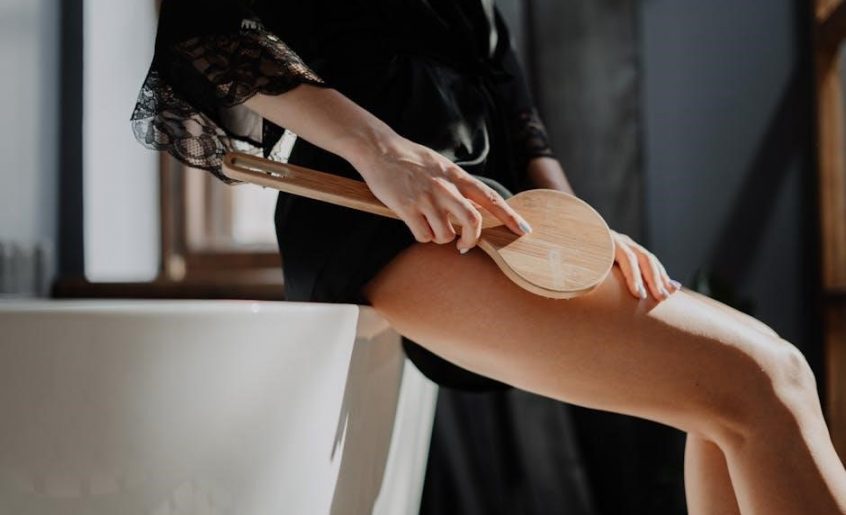Foot massage is a therapeutic technique offering deep relaxation, stress relief, and pain reduction. It’s a skill anyone can learn, providing comfort and rejuvenation for tired feet.
Benefits of Foot Massage
Foot massage offers numerous benefits, including deep relaxation, stress relief, and pain reduction. It improves blood circulation, promoting healthier skin and reducing swelling. Regular massages can alleviate muscle tension, enhance flexibility, and boost mood. Additionally, foot massage supports emotional well-being by creating a sense of comfort and calm. It is also therapeutic for people with specific needs, such as those seeking circulation improvement or pain management. With its universal appeal and accessibility, foot massage is a simple yet effective way to enhance overall well-being and provide comfort to both body and mind.
Preparation for a Foot Massage
Preparing for a foot massage involves creating a relaxing environment and ensuring the feet are clean and dry. Start by washing and drying the feet thoroughly to remove dirt and soften the skin. Use a comfortable surface, such as a cushion or pillow, to support the feet during the massage. Apply a small amount of oil, lotion, or cream to reduce friction and allow smooth strokes. Consider the room temperature and lighting to enhance comfort. Gather any tools, like rollers or massagers, beforehand. Proper preparation ensures a pleasant and effective massage experience for both the giver and receiver.
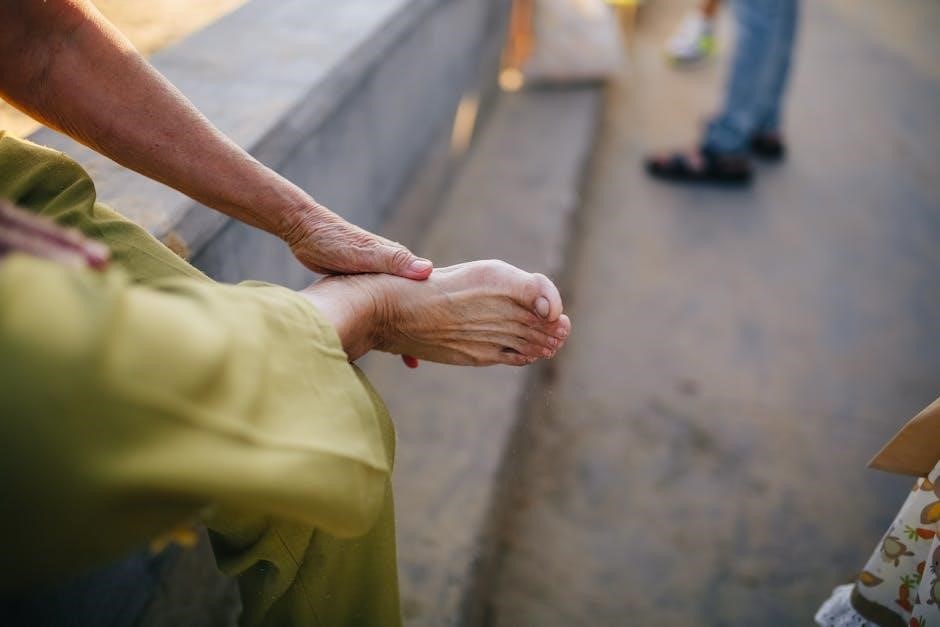
Basic Foot Massage Techniques
Basic techniques include gentle stroking, kneading, and pressing to relieve tension. Start with soft strokes, then gradually apply pressure, focusing on key areas like soles and arches.
Stroking and Kneading
Stroking involves gentle, rhythmic movements along the foot’s surface, while kneading targets deeper tissues. Start with long, soothing strokes from heel to toes to warm up the muscles. Use your thumbs to apply pressure in circular motions, focusing on the arch and ball of the foot. Kneading helps release tension and improve circulation. Be gentle at first, gradually increasing pressure based on comfort. Pay attention to areas with knots or tightness, spending extra time to ease stiffness. These techniques create a calming and rejuvenating experience, making them foundational for an effective foot massage.
Pressure Points and Reflexology
Pressure points and reflexology are based on the belief that specific areas on the feet correspond to organs and systems in the body. By applying gentle, firm pressure to these points, you can promote overall well-being. Common points include the arch (linked to the liver and pancreas) and the ball of the foot (connected to the heart and lungs). Use your thumbs to apply pressure in circular motions, holding each point for 3-5 seconds. Repeat for optimal effect. While reflexology isn’t a medical treatment, it can enhance relaxation, reduce stress, and improve circulation, making it a valuable addition to foot massage routines.
Toe and Arch Massage
Toe and arch massage focuses on relieving tension in the most sensitive and weight-bearing areas of the feet. Start by gently stretching and pulling each toe to release stiffness. Use your thumbs to apply firm, circular pressure to the arch, working from the heel to the ball of the foot. This technique can help alleviate pain and improve flexibility. Spend extra time on areas with tightness or knots, as these often hold stored tension. Massaging the arch can also enhance circulation and reduce muscle fatigue, leaving the feet feeling refreshed and rejuvenated. This step is essential for a comprehensive foot massage experience.
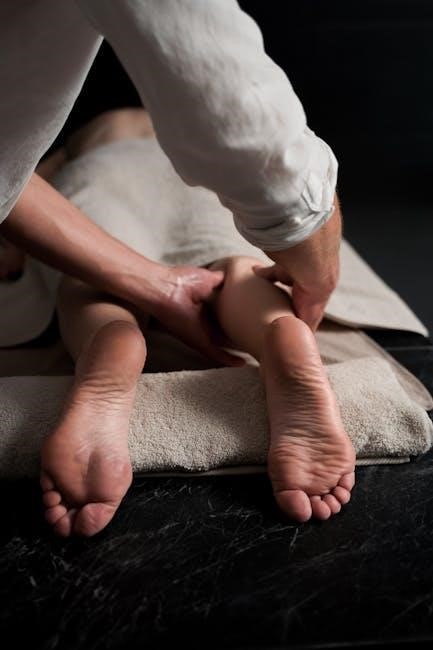
Advanced Foot Massage Techniques
Advanced techniques like toe stretching, ankle rotations, and deep tissue work enhance flexibility and relieve chronic tension. These methods target specific areas for optimal relaxation and improved mobility.
Toe Stretching and Pulling
Toe stretching and pulling is an advanced technique that enhances flexibility and relieves tension. Gently stretch each toe away from the foot, then pull individually to release tightness. This method improves circulation, reduces stiffness, and rejuvenates the feet. Start with gentle pressure, gradually increasing as comfort allows. Use massage oils for smoother movements and to hydrate the skin. Focus on the spaces between toes, where tension often builds. Regular practice can prevent foot pain and improve overall mobility. Always be mindful of the recipient’s comfort level and adjust pressure accordingly to ensure a relaxing and beneficial experience.
Ankle Rotations and Mobilizations
Ankle rotations and mobilizations enhance flexibility and relaxation. Hold the foot by the heel, gently rotating it clockwise and counterclockwise. This improves joint mobility and eases tension. Use your hands to support the ankle, applying gentle pressure to stretch the tendons. Mobilizations involve subtle movements to release stiffness, promoting better circulation. Start with gentle rotations, gradually increasing intensity based on comfort. This technique is particularly beneficial for individuals with limited ankle mobility or those who spend long hours on their feet. Regular practice can reduce stiffness and improve overall foot health, ensuring a more relaxed and rejuvenated experience during the massage.
Heel and Ball of the Foot Massage
The heel and ball of the foot are key areas for massage, offering significant relief from tension and discomfort. Use firm, circular motions with your thumbs to target the heel, focusing on areas with knots or tenderness. For the ball of the foot, apply gentle pressure using your fingertips, moving in slow, deliberate strokes. This helps reduce strain from daily activities and improves circulation. Incorporate deep tissue techniques if needed, but always adjust pressure based on comfort. Massaging these areas can alleviate pain, enhance flexibility, and leave the feet feeling refreshed and revitalized, making it a cornerstone of any effective foot massage routine.
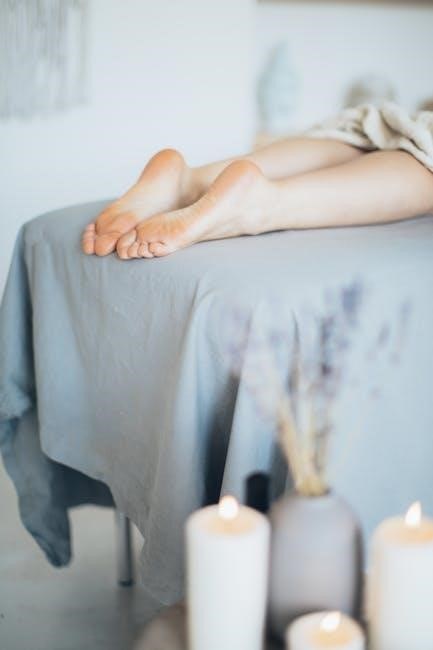
Foot Massage Safety and Contraindications
Foot massage should be avoided if you have open wounds, eczema, or severe foot injuries. Consult a professional if you have medical conditions like diabetes or poor circulation.
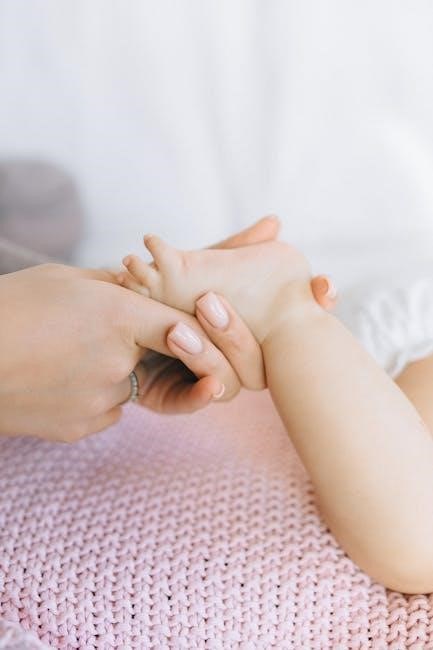
When to Avoid Foot Massage
Foot massage should be avoided in certain situations to prevent discomfort or complications. If you have open sores, infections, or severe foot injuries, it’s best to avoid massage until healed. Additionally, individuals with certain medical conditions, such as diabetes or poor circulation, should consult a healthcare provider before receiving a foot massage. Avoid massaging feet with active fungal infections like athlete’s foot or psoriasis, as it may worsen the condition. Post-surgery foot massage should also be avoided until cleared by a doctor. Overusing foot massagers can cause fatigue, so limit sessions to 10 minutes. Always prioritize safety and health.
Common Mistakes to Avoid
When giving a foot massage, it’s important to avoid common mistakes to ensure a safe and effective experience. Avoid applying too much pressure, especially on sensitive areas like the arches or toes, as this can cause discomfort. Overmassaging or using a foot massager for too long can lead to fatigue or soreness. Neglecting to warm up the feet or skipping proper preparation can make the massage less enjoyable. Using oils or lotions that are too greasy or likely to cause allergic reactions should also be avoided. Lastly, not asking for feedback during the massage can prevent you from tailoring the experience to the person’s needs. Being attentive and considerate is key to a great foot massage.
Consulting a Professional
Consulting a professional for a foot massage is highly recommended, especially for those with specific needs or conditions. A trained therapist can provide personalized techniques tailored to address issues like chronic pain, poor circulation, or discomfort from injuries. Professionals are equipped with advanced methods and tools to deliver deeper relief and relaxation. If you’re unsure about proper techniques or pressure points, a professional ensures safety and effectiveness. Additionally, they can offer guidance on aftercare and maintenance to prolong the benefits of the massage. For optimal results, especially for persistent foot problems, seeking a professional is often the best approach.
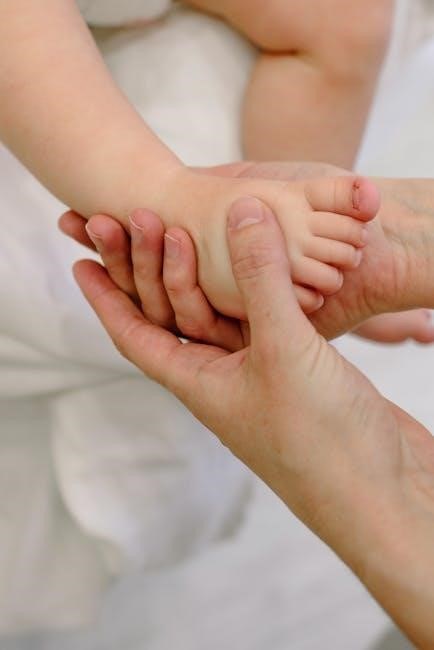
Using Foot Massage Tools and Oils
Essential oils like coconut, almond, and peppermint enhance foot massages with hydration and relaxation. Tools such as rollers and massagers provide targeted relief, while lotions soften skin.
Essential Oils for Foot Massage
Essential oils elevate foot massages by offering unique benefits. Coconut oil deeply hydrates dry feet, while almond oil absorbs quickly, providing lightweight moisture. Peppermint oil cools and reduces fatigue, and lavender oil promotes relaxation and improves sleep quality. These oils can be blended or used individually based on personal preferences and skin types, ensuring a personalized experience. Proper dilution with a carrier oil is recommended to avoid irritation. When incorporated into a foot massage, essential oils not only nourish the skin but also create a calming, spa-like atmosphere, enhancing the overall therapeutic experience.
Foot Massage Creams and Lotions
Foot massage creams and lotions are designed to enhance the experience by reducing friction and deeply moisturizing the skin. Rich ingredients like shea butter and vitamin E nourish and soften rough patches, while lightweight formulas ensure smooth strokes during the massage. Many creams are infused with essential oils for added benefits, such as peppermint for cooling or lavender for relaxation. When selecting a lotion or cream, consider skin type and personal preferences. Avoid heavy or greasy products that may interfere with the massage technique. Proper use of these products ensures a luxurious and rejuvenating foot massage experience for both giver and receiver.
Foot Rollers and Massagers
Foot rollers and massagers are excellent tools for relieving tension and improving circulation. Manual rollers allow for targeted pressure on specific areas like the arches and heels, while electric massagers offer vibration and heat for deeper relaxation. To use, simply roll the device under your feet, applying gentle to firm pressure as needed. For electric models, adjust settings for comfort. These tools are ideal for self-care or as a complement to manual massage. However, avoid using them if you have open sores or certain skin conditions. They’re not a substitute for professional treatment but can enhance your foot care routine significantly.
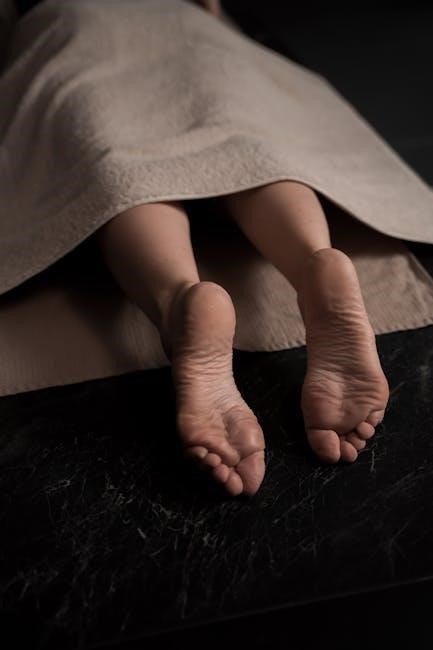
Foot Massage for Specific Needs
Foot massage addresses various needs, from stress relief to pain reduction and improving circulation. Tailored techniques provide targeted benefits, enhancing overall well-being and addressing specific discomfort effectively always;
Foot Massage for Stress Relief
Foot massage is a natural remedy for stress relief, promoting deep relaxation and calming the mind. Gentle strokes and pressure on specific reflexology points reduce tension, easing mental and physical strain. The soothing effects of techniques like kneading and rolling can lower cortisol levels, helping to alleviate anxiety. Incorporating essential oils, such as lavender, enhances relaxation, while focused pressure on the soles and arches can melt away stress. Regular foot massages improve mood, reduce fatigue, and create a sense of well-being, making it an ideal practice for managing daily stress and promoting emotional balance. It’s a simple yet powerful way to unwind.
Foot Massage for Pain Relief
Foot massage is an effective way to alleviate pain, particularly for those suffering from conditions like plantar fasciitis or arthritis. Techniques such as deep tissue work and targeted pressure on areas like the heel and arch can reduce discomfort. Massaging reflexology points, such as those linked to the lower back and legs, can also provide relief. Using tools or hands to apply gentle to firm pressure helps break up tension and improve circulation, easing pain. Incorporating oils like peppermint for a cooling effect can enhance the experience. Regular foot massages can significantly reduce chronic pain, promoting comfort and mobility in daily life.
Foot Massage for Circulation Improvement
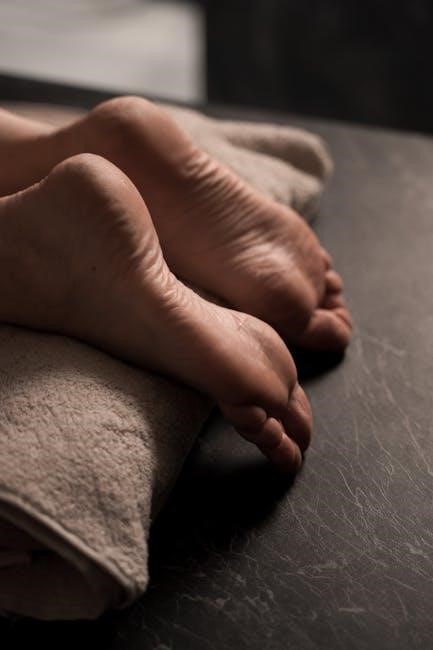
Foot massage is a natural way to enhance blood flow and improve circulation. Techniques like ankle rotations, toe stretches, and gentle pressure on the soles stimulate blood vessels, promoting healthy circulation. Massaging reflexology points associated with major organs can also boost overall circulatory health. Using oils like peppermint or eucalyptus can warm the skin and further enhance blood flow. Regular foot massages help prevent conditions like cold feet or swelling, especially in individuals with sedentary lifestyles. Improved circulation not only benefits foot health but also contributes to overall well-being, making foot massage a simple yet effective practice for better vascular health.

Foot Massage Etiquette and Communication
Communicate openly with the recipient about pressure, technique, and comfort. Always ask for consent and respect boundaries to ensure a relaxing and professional experience.
Asking for Feedback
Asking for feedback during a foot massage is essential to ensure comfort and satisfaction. Check in regularly about pressure and technique, and inquire if specific areas need attention. Open communication helps tailor the experience to the recipient’s needs, fostering trust and relaxation. Encourage honest responses and remain open to adjustments. This ensures the massage is enjoyable and beneficial, creating a positive experience for both parties.
Setting Boundaries
Setting boundaries during a foot massage is crucial for a respectful and comfortable experience. Always discuss expectations beforehand to ensure mutual understanding. Respect personal space and physical limitations, and be mindful of cultural or individual preferences. Ensure both parties feel safe and at ease, and be attentive to non-verbal cues. Clear communication helps establish trust, making the massage enjoyable for everyone involved.
Creating a Comfortable Environment
Creating a comfortable environment is essential for a relaxing foot massage experience. Start by setting the mood with soft lighting and calming music. Use pillows or cushions to support the person’s back and legs while they recline. Ensure the room is warm and free from drafts. Clean and dry the feet before beginning, and consider using a relaxing essential oil like lavender. Position yourself at a comfortable height to avoid strain. A peaceful and private space will help the recipient unwind, making the massage more effective and enjoyable for both parties involved.
Foot massage is a simple yet powerful therapeutic practice, offering relaxation, pain relief, and improved circulation. Regular practice enhances overall well-being and fosters deep relaxation.
Final Tips for a Great Foot Massage
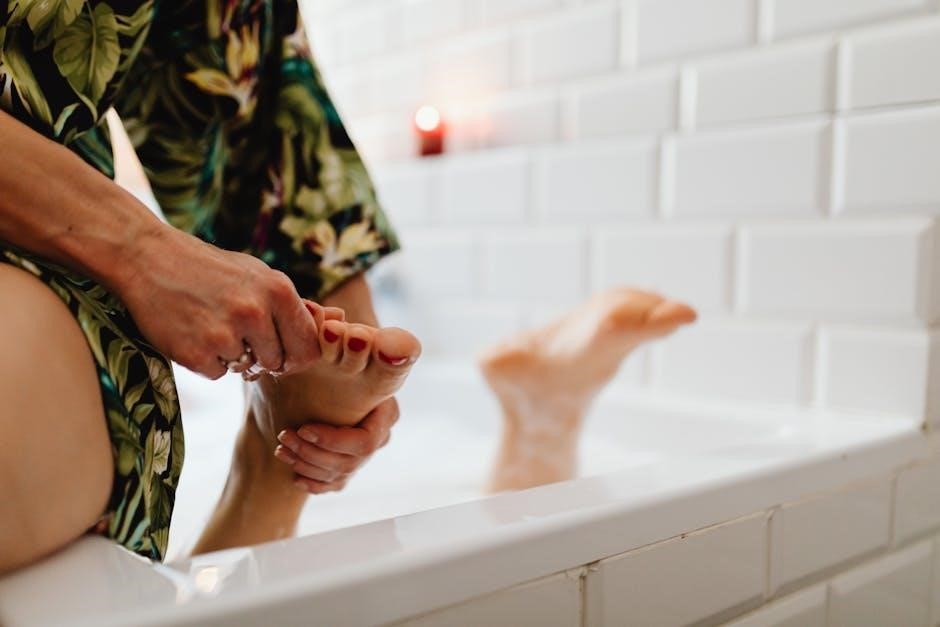
Communicate throughout the massage to ensure comfort and adjust pressure as needed. Focus on key areas like the soles, arches, and toes for maximum relaxation. Use oils or lotions to glide smoothly and avoid friction. Keep sessions between 5-10 minutes to prevent fatigue. Create a calming environment with soft music or dim lighting. Pay attention to feedback and adapt techniques accordingly. Avoid using massagers on skin conditions like eczema or athlete’s foot. End with gentle strokes to leave the feet feeling refreshed and rejuvenated. These tips will enhance your foot massage skills, ensuring a soothing and memorable experience for everyone.
Encouraging Regular Foot Massage
Regular foot massages can significantly improve overall health and wellness. Encourage incorporating foot massage into daily or weekly routines for relaxation and rejuvenation. Start with short sessions, even 5-10 minutes, to make it manageable. Create a calming environment with soft music or dim lighting to enhance the experience. Use oils or lotions for smooth strokes and to hydrate the skin. Consistency helps improve circulation, reduce stress, and alleviate foot pain. Over time, regular foot massages can lead to better sleep quality and overall well-being. Make it a habit to prioritize foot care for long-term health benefits.
